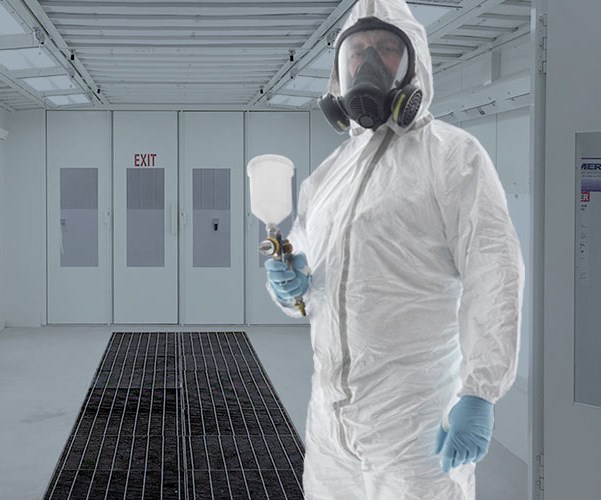
Source | Global Finishing Solutions
Q: How do I choose the right personal protective equipment (PPE) to use for my paint shop?
Even paint booths with the most advanced technology, best airflow and latest high-end features cannot protect a painter’s face and body from exposure to hazardous chemicals and fumes when spraying.
Featured Content
Personal protective equipment (PPE) is needed to keep painters safe on the job and help them avoid short- and long-term health risks. For PPE to be most effective, you must determine what PPE is appropriate for your operation and ensure you are using the right type.
Here are five of the most common questions about PPE for spray booths:
Why is spraying paint dangerous?
Paint fumes contain volatile organic compounds (VOCs) that can enter your system through inhalation or skin absorption. Short-term effects of exposure to VOCs include nausea, dizziness, headaches, shortness of breath and skin irritation. With repeated exposure to VOCs, symptoms can worsen and more serious health issues may arise, most notably throat irritation, difficulty breathing and kidney damage. Prolonged VOC exposure can even cause chronic obstructive pulmonary disease (COPD), strokes and cancer.
What regulations exist regarding PPE usage?
According to OSHA, employees must have access to respirators to wear when spraying paint to protect their health. Respirators are recommended when the technician is working downstream of the object being sprayed.
To determine which level of PPE is necessary, check the safety data sheet (SDS) provided by your paint supplier. The SDS will identify the hazards that are present in the paint in the “Health Hazard Data” section, as well as the recommended PPE to mitigate your risk in the “Exposure Control/Personal Protection” section.
Your local authorities having jurisdiction (AHJ) — including OSHA inspectors, state workplace inspectors, health department officials, fire marshals or insurance company inspectors — may also specify what type of PPE is needed for your operation. PPE requirements often depend on the AHJ’s opinion and widely vary from city to city, county to county and state to state.
Why is air monitoring necessary for your paint booth?
Air monitoring allows finishers to determine exposure levels inside a paint booth. If exposure levels exceed OSHA’s Permissible Exposure Limit (PEL) for the solvent being applied, a respirator must be worn.
In addition, air monitoring can serve as an indicator of the health of your paint booth. If the number of particles in the air is rising, you may have a problem with your booth’s filtering or air makeup system
Is one type of PPE suitable for all painters?
When it comes to PPE, one size does not fit all. For example, painters with beards or prescription glasses may require different PPE. The PPE must fit comfortably and enable the person wearing it to properly perform their job, communicate effectively and move without restriction.
If you are wearing a respirator when spraying paint, a fit test should be performed to ensure that there is an adequate seal to your face. The respirator should fit snugly on your face, with no openings through which you could inhale VOCs.
How can you avoid isocyanates?
Most paints and varnishes contain isocyanate compounds, dangerous chemicals that can irritate your skin or cause breathing issues when inhaled. A painter can become sensitized and allergic to the coatings they are spraying if their exposure to isocyanates reaches a certain level. This can result in breathing problems, asthma, hives and rashes, and, if exposure is extreme, it can even end a painter’s career.
To avoid exposure to isocyanates, technicians should wear a full-body paint suit when spraying. Nitrile gloves are recommended to protect against isocyanate sensitization. A full mask is also essential, and, if the mask includes a fresh-air supply, it can keep the painter cooler in the booth. When using a fresh-air supply, a carbon monoxide meter should also be worn by the painter or installed in the fresh-air system.
Rather than putting your health at risk, it is best to be overly cautious when selecting PPE for your paint operation. The consequences of cutting corners with PPE can be detrimental to your health and can potentially end your career as a painter. Use the SDS from your paint supplier to determine what PPE you need, then confirm that it meets the specifications of your local authorities.
RELATED CONTENT
-
Coating Systems with the Best Long-Term Performance
The best protection against corrosion and UV exposure, says Axalta’s Mike Withers, is electrocoat and a super durable powder coating.
-
Troubleshooting Bright Nickel Processes: How to Identify the Problem
For bright nickel process troubleshooting, Doug Lay of Coventya suggests narrowing the scope with a checklist.
-
Understanding Paint Atomization
BASF coatings development expert Tim December explains how paint atomization works for both pneumatic spray applicators and high-speed rotary bell applicators.



















